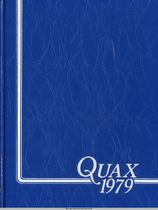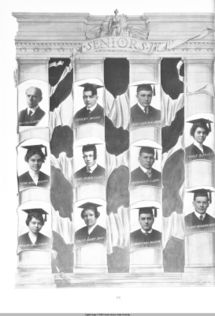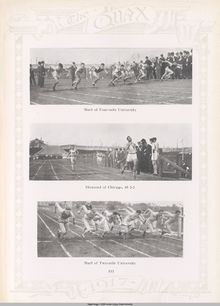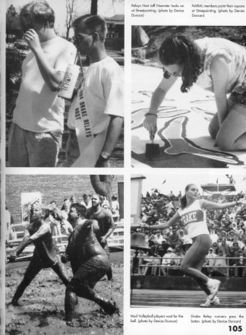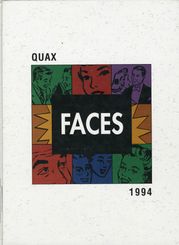The Quax
The Quax (1900-1994)
Originally submitted by Alyson Collins, Drake University, December 13, 2010
Drake University's yearbook, the Quax, is no longer in production, but it holds a deep history and is a Drake tradition that lasted for many years. Production of the yearbook began in 1900 with the earliest edition in Cowles Library dating back to 1904. Recently, the yearbooks have been digitally archived in the Drake Heritage Collections, which is accessible online through Cowles Library. [1] The Quax is important to Drake's history and each edition is filled with pages of memories of great Drake traditions, as well as of many influential people who graduated from Drake. Drake does not currently have a yearbook that its students can purchase, but in the future, a new one could arise if there was enough student interest and dedication to back its production.
The Quax Over the Years
The Quax began as a student-run organization in the early 1900s. The yearbook was originally supported by student fees and through its yearly subscriptions. The first yearbook included drawings and stories done by students along with their student signatures, pictures of faculty members, and a few pages dedicated to each class. A lot of hand-drawn artwork made the yearbook something very unique and something to be cherished. Until the 1931 edition of the Quax, the yearbook was put together by the junior class, so the year the yearbook was published was a year later than the edition of the yearbook.[1] Over the years, the yearbook began to become more and more digitized as technology improved, grew in size and page number, and even began to incorporate color.
What differs about the Quax from other yearbooks is that most of the editions, up until the most recent years, included advertisements for local businesses. The reason for this was to provide for extra funds to keep the yearbook running. Something else to note about the Quax is that after the year book came back from being discontinued, not everyone would get their picture into the yearbook. Part of the new revamping allowed the students who wanted their photo in the yearbook to sign up for a time to get their picture taken. In times of difficulty, the turn out for these student photos would indicate the level of interest among the student body and determine if the yearbook would be produced. The reason that it was decided to try and get individual photos into the yearbook was because yearbooks from other schools of Drake's size were doing so. Editor Julie Ester at the time of these changes stated "We like to keep pace with other yearbooks."[2] In the earlier yearbooks, the student pictures were accompanied by a quote or saying, while in the later years the student's name and major would appear below their photo. Each yearbook had acknowledgement for faculty and staff, as well as students.The yearbooks also included activities and traditions on campus. In the later years, which had more pages to fill, sports, Greek life, and other student organizations were included as well. Traditions like the Homecoming and the infamous Drake Relays would never be forgotten because they were captured into the Quax. Regardless of the year, each edition of the Quax was filled with memories of the past years and of the student's experiences at Drake University.
Funding Controversy
It was not always smooth sailing for the Quax. In 1976 and 1977, no yearbook was issued. The organization fell through and student interest had decreased drastically; however, students brought the yearbook back in 1978, as it was an important artifact for their experiences at Drake.[1] When the Quax was brought back, it was no longer supported by student fees; instead, it supported itself. The Quax was newly improved as well. It was thirty percent larger in size, had the possibilities of more color, and a more elaborate cover was included.[2] The new Quax, however, did not have all of the funding it needed to support itself.
In 1980 a need for an increase in student salaries and new equipment costs caused the Quax to go to the Board of Student Communications (BSC) for funding. The Quax requested $10,980 to meet these new needs; the problem was that the yearbook's income was remaining the same while the costs for producing it were increasing. The BSC rejected this request; they were concerned about giving money to the organization for funding and then having the organization charge students to purchase the yearbooks. [3] Determined to keep the Quax alive, the yearbook staff resubmitted their request. The yearbook organization argued that funding was appropriate because it was a student organization serving the university and students. Despite this, their request was rejected once again.[4]
The yearbook struggled, but managed. In the years to follow up until 1985, the organization producing the Quax incurred a $17,417 printing debt. They were attempting to support themselves using subscriptions, but failing as one thousand yearbooks had to be sold each year to break even, and the numbers sold fell very short of that number. During the spring of 1985, the Student Fees Allocation Subcommittee granted the yearbook the money it needed to pay its debts, but other solutions to problems in the future would include raising the price of the book, cutting the number of pages, and asking for more funding from the BSC. While the new support would keep the Quax alive for a few more years, this was not the end of their issues. Many believed in the future of the Quax, especially the Quax advisor at the time, Bob Brodie. He stated that "the Quax is an important historical record of the university, and it must be maintained during periods of high student interest as well as during periods of low student interest." At this point in time there were many who pushed for the continuation of the Quax, but it was evident that disinterest was growing.[5]
The Quax Discontinued
In April of 1996 the Times Delphic released that the Quax would no longer be produced. Due to no applications for the position of yearbook editor, and the lack of interest on campus, the Board of Student Communications made the decision to cut the yearbook. The Board of Student Communications cut the Quax's funding, thus ending its long run as Drake's yearbook, due to very few subscriptions during the previous year and the organization missing some important deadlines. This did not come as a surprise to many, as the yearbook was not published in the last two years and because of the troubles with finances that the Quax had seen in the past. Director of Student Organizations at the time, Jan Wise shared, "For a tradition to continue, people must believe in it." At that point in time, there was little faith or dedication to keep the Quax alive. Although the ending of the Quax meant the end of a great Drake tradition, the copies that still exist today hold the memories of Drake's past for many to see in the years to come.[6]
Sources
- [1] Schmidt, Bart. (2009, April 9). Drake University Yearbooks. Retrieved from http://library.drake.edu/pages/drake-university-yearbooks
- [2] Quax is Revamped. (1979, September 21). The Times Delphic, p.9.
- [3] Masson, Jon. (1980, February 1). Quax fund request denied. The Times Delphic, p. 2.
- [4] Anderson, Peggy. (1980, February 19). Quax makes new budget request. The Times Delphic, p. 2.
- [5] Moss, Craig. (1986, March 7). Quax seeks funds in order to survive. The Times Delphic, p. 1.
- [6] Thamen, Katie. (1996, April 2). BSC permanently ends yearbook. The Times Delphic, p. 1.
